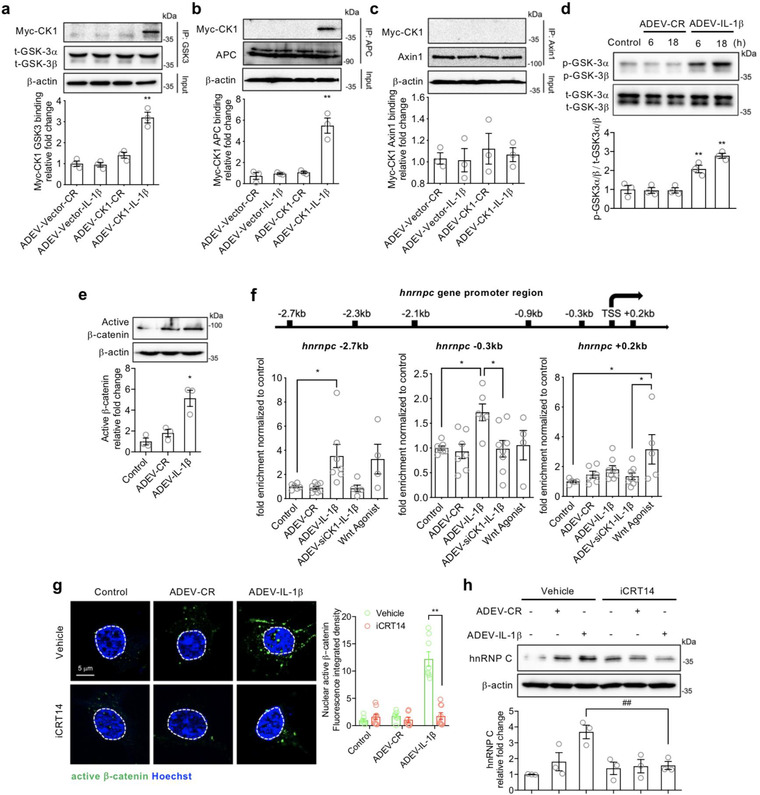FIGURE 6.

CK1 carried in astrocyte derived EV‐IL1β directly binds to GSK3α/β and APC in target neurons. Neurons were treated with astrocyte derived EV‐Vector‐CR (ADEV‐Vector‐CR), astrocyte derived EV‐Vector‐IL1β (ADEV‐Vector‐IL1β), astrocyte derived EV‐CK1‐CR (ADEV‐CK1‐CR), and astrocyte derived EV‐CK1‐IL1β (ADEV‐CK1‐IL1β) for 18 h. (a) GSK3‐Myc‐CK1, (b) Axin1‐Myc‐CK1 and (c) APC‐Myc‐CK1 were immunoprecipitated and the immunoblot probed for Myc tagged CK1. Myc‐CK1 was quantified by band density. (d) Neurons were treated with astrocyte derived EV‐CR (ADEV‐CR) or astrocyte derived EV‐IL1β (ADEV‐IL1β) for 6 and 18 h, Total GSK‐3α,β and ‐GSK3α,β were detected by Western blot and quantified by densitometry. (e) Neurons were treated with astrocyte derived EV‐CR or astrocyte derived EV‐IL‐1β for 18 h and active β‐catenin expression was measured by Western blot and quantified by densitometry. (f) Neurons were treated with astrocyte derived EV‐CR (ADEV‐CR), astrocyte derived EV‐IL1β (ADEV‐IL‐1β), astrocyte derived EV‐siCK1‐IL1β (ADEV‐siCK1‐IL‐1β), and Wnt agonist (20 μM) for 18 h. The binding of β‐catenin to Hnrnpc promotor sites at ‐2.7, ‐0.3 and +0.2 kb were measured by chromatin immunoprecipitation ChIP‐qPCR analysis. Data are mean ± SEM of n = 3‐8 independent experiments per condition. *P < 0.05, **P < 0.01, one‐way ANOVA with Tukey post hoc comparisons. (g) Neurons were treated with astrocyte derived EV‐CR, astrocyte derived EV‐IL1β in the presence and absence of the β‐catenin inhibitor iCRT (20 μM) for 18 h. The nuclear translocation of β‐catenin was visualized by immunofluorescence and quantified by fluorescence intensity. Nuclear staining with Hoescht33342 is shown as blue and active β‐catenin is green. Data are mean ± SEM of n = 8 independent experiments per condition. **P < 0.01, one‐way ANOVA with Tukey post hoc comparisons. (h) Neuronal hnRNP C expression was detected by Western blot and quantified by densitometry following the indicated treatment conditions. Data are mean ± SEM of n = 3 independent experiments per condition **P < 0.01, one‐way ANOVA with Tukey post hoc comparisons
